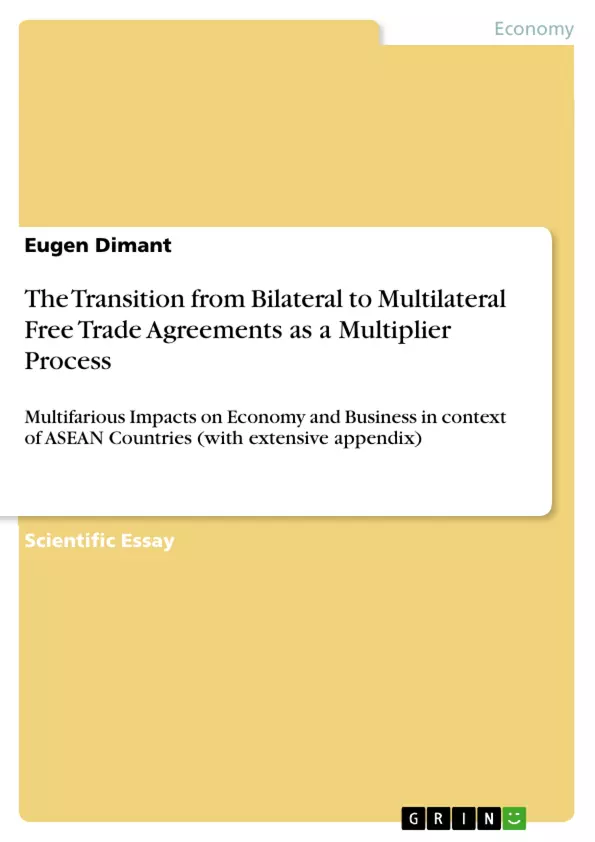Stemming from the ongoing globalization, the process of global integration and international trade has accelerated ever since. Where back in the days the trade was more or less bounded to inter-regional trade with customers, partners and countries in close proximity, nowadays goods are shipped throughout the world, costs of transportation have decreased, time to market has increased and thus the needs and desires can be served almost instantly throughout the world particularly because of the continuous support of the WTO, where “a plethora of bilateral and regional trading and economic cooperation agreements have been mushrooming globally, and increasingly in the Asia-Pacific, generating a wave of “new regionalism” in Asia” (Sen; Srivastava 2009: 194). Concerned by the Asian financial crisis in 1997-1998, the ASEAN countries were under the impression of a slowdown in pace of trade liberalization and thus this put pressure on these countries to engage sustainably in mutual beneficial trade and economic integration. By that, “at a theoretical level regional economic integration is being taken to mean deepening of intra-regional trade, expansion of mutual foreign direct investment (FDI) and harmonization of commercial regulations, standards and practices.” (Ekanayake; Veeramacheneni 2009: 2). This proceeding integration in ASEAN has mainly been motivated by the intention to create an attractive production base and to satisfy the rising competitive challenge on the part of China and India for both, domestic and foreign companies. (Hew; Sen 2004: 1-2). The impact especially of the ASEAN countries has raised over time, mainly in comparison to the OECD countries. “At the same time that developing Asia‟s share in ASEAN trade has been rising substantially (from about one-third to nearly one-half of total ASEAN exports and imports over the 1990-2004 period), the share of major OECD countries has fallen commensurately.” (Naya; Plummer 2006: 231). As a reason for that “both trade and financial liberalization are believed to have propelled faster the long-run economic growth of the East Asian economies.” (Masron; Yusop 2008: 292).
Inhaltsverzeichnis (Table of Contents)
- Introduction
- The Fundamental Perceptions of the ASEAN Community and its Improvement Opportunities
- Economic Incentives to Engage in Bilateral Free Trade Agreements
- The Transition to Multilateral Free Trade Agreements and their Economic Impacts
- Challenges and Prospects
Zielsetzung und Themenschwerpunkte (Objectives and Key Themes)
This term paper examines the transition from bilateral to multilateral free trade agreements within the context of the ASEAN countries. The paper explores the economic incentives driving bilateral agreements, the implications of transitioning to multilateral arrangements, and the associated challenges and prospects for these nations.
- The impact of globalization and regionalism on ASEAN countries.
- The economic incentives for engaging in bilateral free trade agreements.
- The economic impacts of transitioning to multilateral free trade agreements.
- The challenges and prospects of free trade agreements within the ASEAN region.
- The role of the WTO in facilitating and regulating trade liberalization.
Zusammenfassung der Kapitel (Chapter Summaries)
- Introduction: The paper sets the context for the study by discussing the accelerated pace of globalization and the rise of bilateral and regional trade agreements. It highlights the importance of ASEAN's commitment to economic integration in light of global economic challenges and competition from countries like China and India.
- The Fundamental Perceptions of the ASEAN Community and its Improvement Opportunities: This chapter likely delves into the goals and objectives of the ASEAN community, examining its aspirations for regional integration and the strategies employed to achieve these aims.
- Economic Incentives to Engage in Bilateral Free Trade Agreements: This section likely explores the motivations behind ASEAN countries' involvement in bilateral free trade agreements. It may examine the economic benefits such agreements offer, including increased market access, reduced trade barriers, and the promotion of investment.
- The Transition to Multilateral Free Trade Agreements and their Economic Impacts: This chapter examines the challenges and opportunities associated with transitioning from bilateral to multilateral free trade agreements. It may analyze the potential for increased economic cooperation, market expansion, and enhanced regional competitiveness.
Schlüsselwörter (Keywords)
The paper focuses on key concepts such as free trade agreements, regional integration, ASEAN, globalization, economic incentives, multilateralism, trade liberalization, and the role of the WTO.
- Quote paper
- Eugen Dimant (Author), 2010, The Transition from Bilateral to Multilateral Free Trade Agreements as a Multiplier Process, Munich, GRIN Verlag, https://www.grin.com/document/165864



